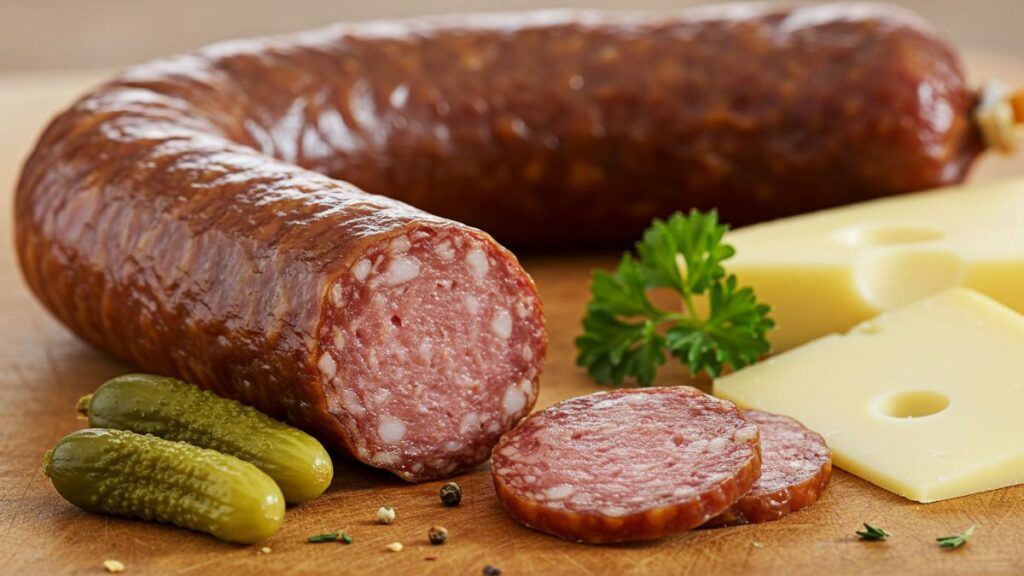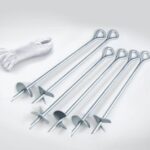What is Summer Sausage?
Summer sausage is a type of cured meat traditionally made from pork, beef, or a combination of both. It’s seasoned with a variety of spices and preserved through fermentation and drying, making it shelf-stable even without refrigeration. The name “summer sausag’e” comes from its ability to be safely consumed during the summer months when refrigeration wasn’t widely available
A Brief History of Summer Sausage
Summer sausage has European roots, with German and Eastern European immigrants bringing their meat-curing traditions to the United States. These sausages were created to last through warm months without spoiling, hence their preservation through fermentation, smoking, and drying. Over time, summer sausag’e became a staple in American homes and holiday gift baskets, especially around Christmas and Thanksgiving.
Ingredients Commonly Used
While recipes can vary, most summer sausages contain:
- Meat: Typically pork, beef, or a mix
- Salt: For flavor and preservation
- Cure: Usually sodium nitrite to inhibit bacterial growth
- Sugar: Helps with fermentation and flavor balance
- Spices: Garlic, mustard seeds, black pepper, coriander, and others
- Fermenting agents: Like lactic acid bacteria or starter cultures
Some recipes also include cheese, jalapeños, or cranberries for added flair.
How is Summer SausageS Made?
There are two main types of summer sausag’e: fermented and non-fermented. Both go through several common steps:
1. Meat Selection and Grinding
High-quality meat is selected, trimmed of excess fat, and ground to a medium or fine texture.
2. Seasoning and Curing
Spices and curing agents are added. In fermented versions, starter cultures are also introduced.
3. Stuffing into Casings
The seasoned meat mixture is stuffed into natural or synthetic casings and sealed.
4. Fermentation and Drying
Fermentation occurs at controlled temperatures. Then, sausages are dried or smoked.
5. Packaging and Storage
Once ready, summer sausages are vacuum-sealed or wrapped for sale or storage.
Want to hear more tips? Please look at our page for more informative and helpful blog posts.
Why is it Called ‘Summer’ Sausage?
The name originates from its non-refrigerated shelf life, making it ideal for consumption in warm climates or months. Before modern refrigeration, preservation techniques like fermentation and smoking were essential for keeping meat fresh through the summer—hence the name.
Health Benefits and Nutritional Information
While delicious, summer sausag’e should be enjoyed in moderation due to its sodium and fat content. A typical 1-ounce serving contains:
- Calories: 90-110
- Protein: 5-7 grams
- Fat: 7-9 grams
- Sodium: 300-500mg
Potential Benefits:
- High in Protein: A good snack for energy and muscle support.
- Shelf-Stable: Convenient for hiking, camping, or travel.
- Low Carbohydrates: Suitable for keto or low-carb diets.
Different Types of Summer Sausage
1. Traditional Summer Sausag’e
Made with beef or pork and classic spices like garlic, black pepper, and mustard seed.
2. Venison Summer Sausag’e
A leaner version made from deer meat. Great for hunters and game meat lovers.
3. Spicy Varieties
Includes jalapeños, red pepper flakes, or hot sauces for a bold flavor.
4. Cheese-Infused Sausages
Contains cheddar or pepper jack for added richness and flavor.
How to Store Summer Sausage
One of the key benefits of summer sausag’e is its long shelf life:
- Unopened: Can last up to 6 months unrefrigerated.
- Opened: Should be refrigerated and consumed within 3 weeks.
- Frozen: Can be stored for up to 6 months, though texture may change slightly.
Always check the “best by” date and storage instructions on the package.
Best Ways to Serve Summer Sausage
Summer sausage is incredibly versatile and can be enjoyed in several delicious ways:
1. Charcuterie Boards
Pair with cheeses, crackers, olives, and fruits for the perfect appetizer.
2. Sandwiches
Add slices to subs or deli-style sandwiches for a tangy, meaty bite.
3. Camping and Hiking Snacks
Easy to carry and doesn’t require refrigeration.
4. Pizza Topping
Use instead of pepperoni for a unique, smoky flavor.
5. Breakfast Dishes
Fry slices and serve with eggs and toast.
Homemade Summer Sausage: A DIY Option
Making summer sausage at home is rewarding. Here’s a brief overview:
Ingredients:
- Ground meat (beef, pork, venison)
- Curing salt
- Garlic, pepper, mustard seed
- Sugar or honey
- Starter culture (if fermenting)
Steps:
- Mix meat with spices and cure.
- Stuff into casings.
- Ferment (if desired).
- Smoke or bake at low temp.
- Cool and store.
This method gives you full control over the flavor and ingredients.
Is Summer Sausage Safe to Eat Without Cooking?
Yes, commercially made summer sausag’e is fully cooked and safe to eat without additional cooking. It’s either smoked or cooked during the preparation process. However, always read the label to be sure.
Was this helpful? If so, please keep browsing our site to find more useful information!
Buying Guide: What to Look for
When purchasing summer sausag’e:
- Check ingredients: Look for minimal preservatives and natural spices.
- Examine texture: Should be firm but sliceable.
- Flavor profile: Choose classic, spicy, cheesy, or gamey depending on preference.
- Trusted brands: Opt for known names or artisan producers for better quality.
Sustainability and Ethical Considerations
Many small producers now offer organic, grass-fed, or ethically sourced options. If sustainability matters to you:
- Look for certified humane or pasture-raised labels.
- Support local farms and meat artisans.
- Choose minimally packaged products to reduce waste.
Conclusion
Summer sausage is more than just a snack—it’s a slice of culinary history that brings convenience, flavor, and tradition to the table. Its long shelf life, robust taste, and versatility make it a favorite for picnics, holiday platters, and quick protein-rich bites. Whether store-bought or homemade, this savory sausage can elevate your meals or serve as a satisfying stand-alone treat. With the knowledge from this guide, you’re now ready to choose, enjoy, or even craft your own perfect summer sausage.
If you want to read more, visit our blog page. We have more topics!
FAQs About Summer Sausage
1. Is summer sausage the same as salami?
Not exactly. While both are cured meats, summer sausag’e is usually less dry and less salty than salami. Salami also undergoes a longer aging process.
2. Does summer sausage need to be refrigerated?
Unopened summer sausage can be stored at room temperature, but once opened, it should be refrigerated to maintain freshness.
3. Can you freeze summer sausage?
Yes, summer sausag’e freezes well. Wrap it tightly and store it for up to 6 months.
4. Is summer sausage cooked or raw?
Most summer sausages are fully cooked or smoked, making them safe to eat without additional cooking.
5. How long does summer sausage last after opening?
Once opened and refrigerated, it should be consumed within 3 weeks.
6. Is summer sausage keto-friendly?
Yes, most varieties are low in carbs and high in fat and protein, making them suitable for a keto diet.







